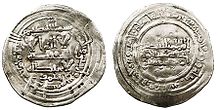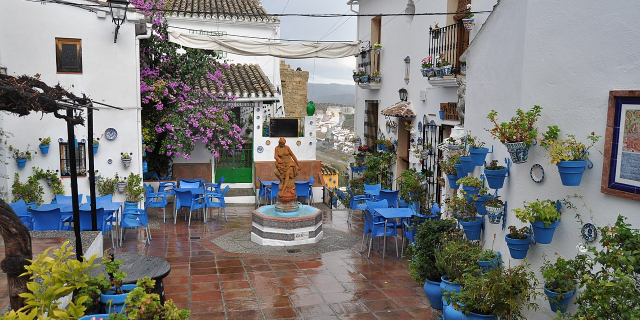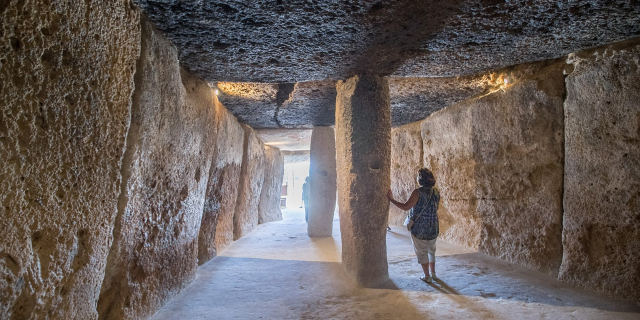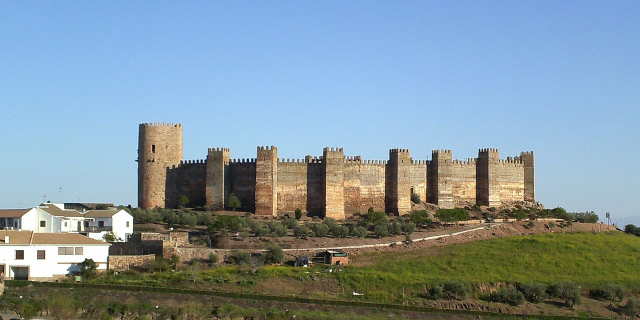Medina Azahara
( Madinat al-Zahra )Madinat al-Zahra or Medina Azahara (Arabic: مدينة الزهراء, romanized: Madīnat az-Zahrā, lit. 'the radiant city') was a fortified palace-city on the western outskirts of Córdoba in present-day Spain. Its remains are a major archaeological site today. The city was built in the 10th century by Abd ar-Rahman III (912–961), a member of the Umayyad dynasty and the first caliph of Al-Andalus. It served as the capital of the Caliphate of Córdoba and its center of government.
The main reason for its construction was politico-ideological: Abd ar-Rahman III had declared himself "caliph" in 929 and the dignity of this new title required the establishment of a new city, a symbol of his power, imitating other eastern Caliphates. It sought to demonstrate his superiority over his great rivals, the Fatimid Caliphs of Ifriqiya in North Africa and ...Read more
Madinat al-Zahra or Medina Azahara (Arabic: مدينة الزهراء, romanized: Madīnat az-Zahrā, lit. 'the radiant city') was a fortified palace-city on the western outskirts of Córdoba in present-day Spain. Its remains are a major archaeological site today. The city was built in the 10th century by Abd ar-Rahman III (912–961), a member of the Umayyad dynasty and the first caliph of Al-Andalus. It served as the capital of the Caliphate of Córdoba and its center of government.
The main reason for its construction was politico-ideological: Abd ar-Rahman III had declared himself "caliph" in 929 and the dignity of this new title required the establishment of a new city, a symbol of his power, imitating other eastern Caliphates. It sought to demonstrate his superiority over his great rivals, the Fatimid Caliphs of Ifriqiya in North Africa and the Abbasid Caliphs in Baghdad. The city was built near Córdoba, the existing capital of al-Andalus under Umayyad rule. Construction began in 936–940 and continued in multiple phases throughout his reign and the reign of his son, Al-Hakam II (r. 961–976). The new city included ceremonial reception halls, a congregational mosque, administrative and government offices, aristocratic residences, gardens, a mint, workshops, barracks, service quarters, and baths. Water was supplied through aqueducts. After al-Hakam II's death, however, the city ceased to act as the center of government under the rule of Ibn Abi Amir al-Mansur (Almanzor). Between 1010 and 1013 it was sacked during a civil war and thereafter abandoned, with many of its materials re-used elsewhere.
The ruins of the city were excavated starting in 1911. Only about 10 hectares of the 112 hectares (0.43 sq mi) of the city have been excavated and partially restored, but this area includes the main palaces. A dedicated archeological museum, located on the edge of the site, was opened in 2009. On July 1, 2018, the site was listed as a UNESCO World Heritage Site with the inscription name "Caliphate City of Medina Azahara".
Abd ar-Rahman III was a member of the Umayyad dynasty, which had formerly ruled the Islamic world as head of the Umayyad Caliphate. The title "caliph" signified the political and spiritual leader of the whole Muslim world. In 750 the Umayyads were overthrown by the Abbasids, who took on the title of caliphs and established a new capital at Baghdad. In 756 Abd ar Rahman III's ancestor, Abd ar-Rahman I, managed to re-establish the dynasty's power in the Iberian Peninsula in the far western part of the Muslim world, known as Al-Andalus. Although independent from the Abbasids, the new Umayyad rulers in Al-Andalus, based in Cordoba, did not reclaim the title of "caliph" at this time. Instead, they ruled as "emirs", a lower title designating local Muslim rulers, as heads of the Emirate of Cordoba. While Arabic and Islamic culture thrived in Al-Andalus during this period, it was still a relatively decentralized realm and the emir in Cordoba often struggled to keep different factions under control.[1][2]
When Abd ar-Rahman III came to power as emir in 912, he began to systematically re-establish Umayyad authority over rebel regions within his realm and reinforce his own authority across Al-Andalus through military and diplomatic means. In 929, after years of constant campaigning, Abd ar-Rahman III felt confident enough to declare himself "caliph", a title equal to the Abbasid rulers in Baghdad (whose own power had significantly weakened by this time). This move may also have been in response to the rise of the Fatimid Caliphate in North Africa around the same time, which challenged the Sunni caliphs of Baghdad and also presented a threat to the interests of the Umayyad state in Al-Andalus.[1][2]
Before the creation of Madinat al-Zahra, the residence and centre of government for the Umayyad emirs had been the Alcázar in the heart of Cordoba, across from which stood the Great Mosque of Cordoba. Many scholars argue that the motives for the construction of a new palace-city must have included a desire to create a capital and residence that would reflect the dignity and grandeur which Abd ar-Rahman III wanted to project around his new caliphate. The creation of such palace-cities also had precedents because both the Abbasids caliphs and the Fatimid caliphs had previously built such cities for themselves.[3][4][5][6]
Construction and development Coins minted at Madinat al-Zahra in 347 AH (958 or 959 CE), in the name of Abd ar-Rahman III
Coins minted at Madinat al-Zahra in 347 AH (958 or 959 CE), in the name of Abd ar-Rahman IIIAccording to historical sources the new palace-city was founded in 936. It was located about 5 km west of Cordoba. Abd ar-Rahman III's son, al-Hakam, the crown prince and his future successor, was entrusted to oversee the construction. The 16th-century writer Al-Maqqari cites a man named Maslama ibn 'Abdallah as the architect of the city, but it is unclear how large his role was or how much of the city he actually designed. Major construction might not have actually started until 940, and evidence suggests that it occurred in stages, with the overall plan changing as further work was executed. The mosque on the site was consecrated in 941. By 945 the caliph was already living in the city. The road between the new city and Cordoba was paved in 946. Finally, in 947 the apparatus of state, including the mint (dar al-sikka), was transferred here from Cordoba. Construction in the city nonetheless continued throughout the remaining years of Abd ar-Rahman III's reign (up to 961) and throughout Al-Hakam II's reign (961–976). High-ranking officials under both caliphs were often involved in the construction as well.[7][8][9]
The whole city was surrounded by a fortified wall with towers.[10] However, there is evidence that only the palaces were protected by a wall at first and that the outer city wall was added after residential areas had already begun to develop outside the palace.[11] Abd ar-Rahman III also arranged for thousands of antique marble columns to be procured or imported from other sites, mostly from Ifriqiya (despite it being under Fatimid control at the time), to be reused for construction here.[12][13] Al-Hakam II also reportedly procured many Roman statues and carved sarcophagi, which were used to decorate the grounds.[12]
Several of the major structures that have been excavated and identified on the site were built over earlier structures and thus appear to belong to a different construction phase after the initial construction of the city. The structures known today as the House of Ja'far and the Court of the Pillars were both built over two or three smaller structures which occupied the same spaces. In addition to being larger than their predecessors, they also feature very different layouts, such as a semi-basilical plan (in the House of Ja'far) and a courtyard surrounded by a porticoed gallery (the Court of the Pillars).[14] Antonio Vallejo Triano, who led archeological work at the site between 1985 and 2013, has argued that the Court of the Pillars likely dates from the 950s. Likewise, the large Upper Basilical Hall, also known as the Dar al-Jund ("House of the Army"), is believed to date from this time.[14] The construction of the Salón Rico, or Reception Hall of Abd ar-Rahman III, has been dated to between 953 and 957 thanks to several inscriptions featured in its decoration.[15][16] The supervisor of the hall's construction was Abdallah ibn Badr, the vizier and highest-ranking official under the caliph at that time. The decoration was executed under the supervision of the caliph's eunuch servant Shunaif, although it's unclear if he was also involved in the design of the hall.[17]
Based on the evidence of these constructions, Vallejo Triano has argued that a fairly significant remodelling of the palace complex took place in the 950s. It followed a trend of larger and more monumental buildings which made use of porticos, arcades, and different basilical layouts. These new structures were often built over older, relatively more modest structures, and were thus designed to increase the impression of the caliph's magnificence through the architecture of his city.[14] Vallejo Triano notes that this period would also coincide with a major reorganization of the state by Abd ar-Rahman III in 955, which is reported by historical sources such as Ibn Idhari.[18] Additionally, Abd ar-Rahman III was likely becoming better-informed about the rich palaces and elaborate court ceremony in the new Fatimid capital, Mahdia, and in the Byzantine capital of Constantinople. For example, some of Abd ar-Rahman III's emissaries to the Byzantine emperor brought back with them gilded bronze sculptures, marble fountain basins decorated with animal figures, and other decorative architectural elements. This growing awareness of other imperial courts and Abd ar-Rahman's desire to match them may explain an increase in the complexity of the ceremonies and court protocols surrounding the caliph around this time, to which historical sources of the time attached great importance, along with an increase in the architectural scale of the new buildings.[19]
Vallejo Triano has also argued that the construction of the House of Ja'far took place slightly later than the other structures of the 950s because its decoration appears to be more evolved. This tentatively supports an earlier hypothesis by Félix Hernández Giménez that this large residence was built for Ja'far, a hajib (chamberlain) of Al-Hakam II between 961 and 971, and for whom the structure is currently named. This also makes it the only major structure in Madinat al-Zahra that has been identified as belonging to the reign of Al-Hakam II.[14][20]
Life and government within the palace-city The Pyxis of al-Mughira, one of the luxury items produced in the workshops of Madinat al-Zahra, dated to 968 and now kept at the Louvre Museum[21]
The Pyxis of al-Mughira, one of the luxury items produced in the workshops of Madinat al-Zahra, dated to 968 and now kept at the Louvre Museum[21]The palaces housed the caliph's household, including a large number of concubines. The residents were served by a large body of slaves, including eunuchs, of mostly European origin.[22] The city also contained a throne hall or audience chamber (the Salón Rico), government offices, workshops that produced luxury objects, the residences of high officials, and – on the lower levels of the city – markets and residential districts for the common workers.[23][24][25] The city had a manager, a judge, and a police chief.[26] Under the cultured caliph Al-Hakam II in particular, there was also a library which by some accounts contained hundreds of thousands of volumes in Arabic, Greek, and Latin.[22] The main mosque (also known as the Aljama Mosque), and one or more small neighbourhood mosques, provided religious services.[24]
The palaces were furnished with silks, tapestries, and various luxury objects. Many objects produced in the caliph's official workshops were given as gifts and have made their way into the collections of museums and Christian cathedrals.[25] Among the wonders reported by historical chronicles about the palaces, Al-Maqqari described a domed hall in the palace which contained a pool of liquid mercury which reflected light and could be stirred to create dazzling ripples of light, although the location of this hall has not been found by modern archeologists.[10][27]
The new caliphate also developed an increasingly elaborate culture of court protocols around the figure of the caliph. Lavish festivals and receptions were hosted to impress foreign ambassadors.[28] The organisation of the city seems to have included a specific path to be followed by foreign guests and dignitaries on their way to the caliph's audience chamber, which was fronted by gardens and pools with vistas over the rest of the city and the valley below.[26] The caliph himself would appear seated at the back and center of his audience chamber, surrounded by courtiers and officials, with the architecture designed to focus on his position.[29] While the caliph increasingly took on an air of aloofness during this period, the protocols did not evolve to the point of hiding him completely from view – by contrast with the Fatimid caliphs in Africa, who were kept hidden behind a veil.[30]
Various members of the caliph's family, or other wealthy elites, also built their own villas and palaces in the countryside around Cordoba during this period of prosperity in the 10th century. This was a tradition which had existed since the early days of the Emirate and possibly derived from the Roman villa tradition. The caliph even kept some family members in such villas in order to distance them from the center of power in Madinat al-Zahra, providing them with a generous stipend so they wouldn't cause trouble.[24][31]
Construction of Madinat az-Zahira by AlmanzorWhen Al-Hakam II died in 976 he was succeeded by his son Hisham II, who was 14 or 15 years old at the time and had little political experience. Consequently, de facto political power was assumed by Ibn Abi Amir, a strongman who appropriated for himself both the post of hajib (chamberlain) and wazir (vizier) and who adopted the regnal title "al-Mansur" (or Almanzor in European sources).[32] In 978 or 979 (368 AH), after he had secured the monopoly of power, he ordered the construction of a new palace city for himself which rivaled Madinat al-Zahra in beauty.[33][34] Al-Mansur called his palace with a very similar name: Madinat Az-Zahira ("the Shining City").[33][35][34] The location of the palace, which has never been excavated, is still debated: it may have been between Cordoba and Madinat az-Zahra to the west, but the most common hypothesis is that it was built a short distance east of Cordoba, near the banks of the Guadalquivir River, in order to draw the focus of power away from the earlier Umayyad palaces.[34][36][37][38] The new palace took only two years to build. When it was ready Al-Mansur moved the center of government there, leaving the old Madinat al-Zahra in disuse and confining the young caliph Hisham to the old Alcázar in Cordoba instead.[35]
Decline and destructionOn the death of Al-Mansur in 1002, his eldest son Abd al-Malik al-Muzaffar succeeded to power. When al-Muzaffar in turn died in 1008, his brother Abd ar-Rahman, also known as Sanchuelo ("Little Sancho", as his mother Abda was a daughter of Sancho, the king of Navarre) came to power. Less politically able than his father and brother, he tried to appropriate for himself the inheritance of the caliphate from Hisham, which aroused serious opposition. In an attempt to avoid these problems, he set out for a military campaign to the Christian north almost right away. When he crossed the border into Christian territory in February 1009, his opponents broke into the old Alcázar and forced Hisham II to abdicate to another member of the Umayyad family, Muhammad. At the same time, Madinat al-Zahira, the palace built by Al-Mansur and the center of government, was pillaged and destroyed.[39][33]
The next few years were chaotic and resulted in multiple violent confrontations and regime changes between different factions, known as the Fitna (civil war). Between 1010 and 1013 Cordoba was besieged by Berber factions, and by the end of this period Madinat al-Zahra, the city of Abd ar-Rahman III, had been pillaged and left in ruins.[40] For many years afterwards the city continued to be looted by people for its building materials, which nearly erased it from existence.[5] Over time its remains were buried and its location was not identified again until the 19th century, with excavations beginning in 1911.[5][41]


































Add new comment